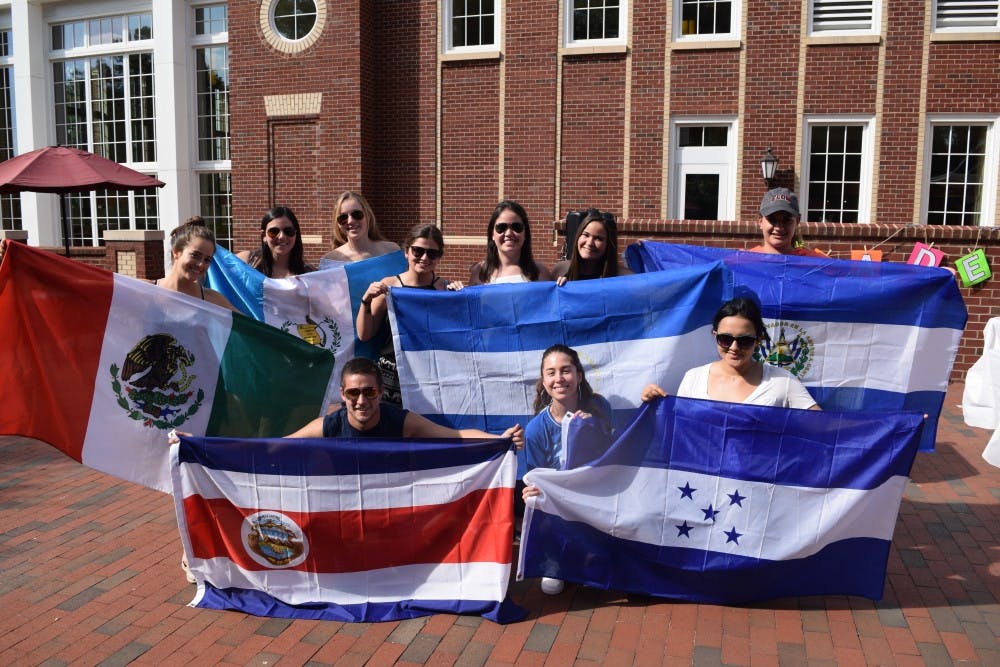Elon University senior Philip Rodriguez thought Latinos on campus were non-existent.
The Cuban-American was born and raised in Miami, a melting pot of a town that exudes racial and cultural diversity.
That dynamic environment is drastically different at Elon, a predominantly white institution. Roughly 6 percent of students identify as Latino or Hispanic at Elon, an increase to the population from 2002, when it was roughly 1.2 percent.
As Hispanic Heritage month comes to a close, students like Rodriguez hope his classmates will become more aware of the Latino/Hispanic community.
Events such as "Fiesta de Independencia," which happened last Friday, Sept. 16, introduced to Elon part of the Latin-American culture with food, music and dance.
Sophomore Kayla Ervin believes these events can engender an impact on campus.
"I think it's great that one can bring our culture to campus," Ervin said. "It is bringing some exposure. It's not where you want to be, but it's a good start. We're at the start of bringing more diversity."
Though Elon may pride itself on being a school that embraces different types of diversity, the Latino/Hispanic population still seeks to find its voice on campus.
Out of the 1,524 freshmen students enrolled at Elon this year, 20 percent identify as ethnically diverse. Hispanic and Latino students make up 7 percent of the freshmen class, with African Americans and the Hispanic/Latino students at Elon now tied for the largest minority on campus, according to Greg Zaiser, vice president of admissions and financial planning.
Sophomore Kimberly Wilson, who comes from a biracial background of New Jersey and Peru,had a hard time finding Latino/Hispanic friends during her first weeks at Elon.
“When I walked into El Centro, I definitely felt immediately at home, just with the decorations and the language, music playing all the time, people eating food and talking while they were doing homework or watching T.V. It has a really nice feel that you can’t find anywhere [else] on campus,” Wilson said.
With resources such as El Centro de Espanol, The Center for Race, Ethnicity and Diversity Education (CREDE), Latin American Student Organization (LASO) and the newly installed Latina sorority, Chi Upsilon Sigma, the Elon community is becoming more aware of the Latino/Hispanic presence. Though these resources may display Latin and Hispanic cultures, there is still a wide gap within the Latino/Hispanic community on campus.
Sylvia Munoz, interim director for the CREDE, believes that the Latino/Hispanic population is spread out at Elon because every student who may identify with this ethnicity is at a different stage of their identity development.
Munoz explained that there are international students coming from their native countries in Latin America or Spain to study at Elon for four years; the first generation Latino/Hispanic students, those who came to the United States when they were little or were born here, but whose parents immigrated from Latin America; and second- or third-generation students who may identify with the ethnicity because their grandparents or other ancestors were from those countries.
All of these groups identify with their ethnicity on different levels.
“People assume you have to speak Spanish in order to be considered Latino or Hispanic,” Munoz said. “We need to get out of the stereotypical notion of what a Hispanic or Latino should look like or behave like.”
Due to the different stages of identity development that Latino/Hispanic students have on campus, it's not easy to group or identify students that make up this ethnicity.
Munoz has worked at Elon for 18 years and has seen a huge change in the growth of the Latino/Hispanic population during the past decade, and even more in the past five years. She realizes that Elon does not have a large population of Latinos/Hispanics because there are major political and social issues that come with the nature of attending a private university.
“We don’t have a big endowment, so it’s going to be hard to recruit diverse students where socio-economic factors have a big say in that. Elon is trying and you can see the efforts,” Munoz said.
Though enrollment has increased, Rodriguez and Munoz acknowledge that socioeconomic factors, being undocumented, not being able to apply or qualify for loans or financial aid, as well as family traditions, have impeded many Latinos/Hispanics from attending college.
Outside factors keep some Latinos and Hispanics from going to college, but once they get to college there are internal factors that result in fragmentation of these communities.
“The wide range of backgrounds that are within our Latino/Hispanic community has made me pause,” said Munoz. “There is not a ‘one program fits all.’ Instead of working through our differences we should work through our similarities.”
Latinos and Hispanics cannot be placed into a specific group because this ethnicity includes multiple countries with various cultures and traditions.
“If we kind of accept that grouping and really realize that if we work together for a common goal then we can almost accomplish anything,” Rodriguez said.
The attempts to unite the Latino/Hispanic community at Elon are still a work in progress. LASO is trying become an umbrella organization for all Latinos/Hispanics on campus while El Centro hosts multiple events throughout Hispanic Heritage month and the rest of the year in order to unite the Elon community.
“I would love us to come together to present ourselves as a united group and make a difference on campus,” Wilson said.
Rodriguez echoed Wilson's sentiments, and hopes that the awareness brought by Hispanic Heritage month will lead to more interaction between different cultures on Elon's campus.
"I hope that the Hispanic/Latino community can come together and reach out to all other communities on campus, Rodriguez said."I hope the Hispanic-Latino community creates an influence of welcoming and warm culture that we know ourselves."


